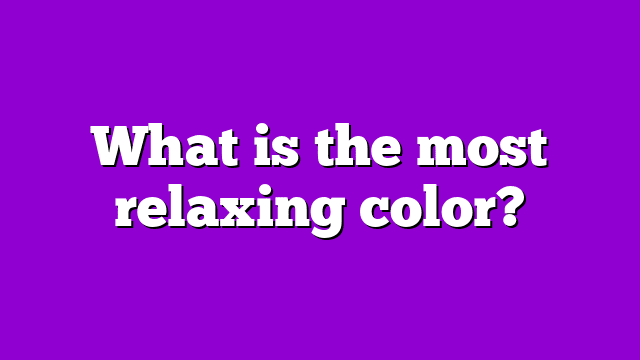Crystal Symbolism & Spirituality
What is the most relaxing color?
The most relaxing color is blue. It is known to promote feelings of calmness and tranquility. Blue is a popular choice for bedrooms, spas, and meditation rooms.
Unfortunately, colors can also have negative side effects. Here are a few examples:
- Red: Can increase blood pressure and heart rate, promote aggression, and stimulate appetite.
- Yellow: Can cause eye fatigue, irritability, and anxiety.
- Orange: Can lead to restlessness and overstimulation.
- Green: Can induce feelings of envy or jealousy.
- Purple: Can be too stimulating for some people and cause restlessness.
It’s important to choose colors carefully and consider how they might affect your mood and well-being. If you find that a particular color is causing negative side effects, it might be best to avoid it in your environment.
Table Of Contents
- 1 Relaxing Colors for the Mind and Body
- 2 The Connection Between Color and Emotions
- 3 Contrasting Effects: Positive vs. Negative Colors
- 4 Harmful Effects of Prolonged Exposure to Certain Colors
- 5 The Psychological Impact of Bright Colors
- 6 How to Balance Your Environment with Colors that Promote Relaxation
Relaxing Colors for the Mind and Body
Color has been found to have a significant impact on our physical and emotional well-being, and certain colors have been known to promote relaxation and calmness in the mind and body. Here are some of the most relaxing colors:
- Blue: Blue is known to have a calming effect on the mind and body, and is often used in bedrooms for its ability to promote restful sleep.
- Green: The color green is associated with nature and is known to induce relaxation and calmness in the mind and body.
- Purple: Purple is often associated with spirituality, and can have a calming effect on the mind and body.
- Gray: A neutral color like gray can help to create a soothing and calming environment.
By incorporating these colors into our environment, we can create a more relaxing and peaceful space for ourselves.
The Connection Between Color and Emotions
Color psychology is the study of how colors can affect our emotions, behavior, and mental state. Different colors have been found to evoke different emotions and moods, and understanding this can help us to use color to our advantage.
For example, warm colors like red and orange are often associated with excitement, passion, and energy, while cool colors like blue and green are associated with calmness and tranquility. Understanding how colors can influence our emotions can help us to create environments that promote relaxation and well-being.
Contrasting Effects: Positive vs. Negative Colors
While certain colors can promote relaxation and calmness, other colors can have the opposite effect, causing feelings of anxiety and stress. Some of the least relaxing colors include:
- Red: Red is often associated with passion and energy, but can also evoke feelings of tension and aggression when used excessively.
- Yellow: Yellow is a bright and cheerful color, but can also be overstimulating and cause feelings of anxiety and restlessness.
- Orange: Orange is a warm and vibrant color, but can also be overstimulating and cause feelings of irritability and restlessness.
- Bright, neon colors: These colors are often associated with excitement and energy, but can be overstimulating and cause feelings of anxiety and discomfort.
It’s important to consider the effects that different colors can have on our emotional and mental state, and to use them in moderation to create a balanced environment.
Harmful Effects of Prolonged Exposure to Certain Colors
While colors can have a significant impact on our emotional and mental state, prolonged exposure to certain colors can have negative effects on our physical health. For example, studies have shown that exposure to high levels of blue light, such as that emitted from electronic devices, can disrupt our sleep patterns and lead to insomnia.
Similarly, prolonged exposure to bright, neon colors can be overstimulating and cause headaches and eye strain. It’s important to be mindful of the colors we are exposed to on a daily basis, and to make changes to our environment if we notice negative effects on our physical health.
The Psychological Impact of Bright Colors
Bright colors can have a powerful psychological impact on our emotions and mental state. Studies have shown that brighter colors can increase feelings of excitement and energy, but can also cause anxiety and overstimulation.
Bright colors are often used to draw attention and create a sense of urgency, which can be useful in some situations but can also cause stress and anxiety if used excessively. It’s important to use bright colors in moderation, and to balance them with more calming and soothing colors to create a well-rounded environment.
How to Balance Your Environment with Colors that Promote Relaxation
To create a relaxing and calming environment, it’s important to balance the use of different colors in our surroundings. Here are some tips for using color to promote relaxation:
- Incorporate calming colors like blue, green, and purple into your decor and furnishings.
- Avoid using overly bright or neon colors in your environment and instead opt for more muted tones.
- Use warm, natural lighting to create a soothing atmosphere in your space.
- Avoid excessive use of electronics and blue light-emitting devices, especially before bed.
- Consider incorporating natural elements like plants and natural materials into your environment to promote relaxation and calmness.
By being mindful of the colors we surround ourselves with, we can create a more relaxing and peaceful environment for ourselves that promotes well-being and calmness in the mind and body.

